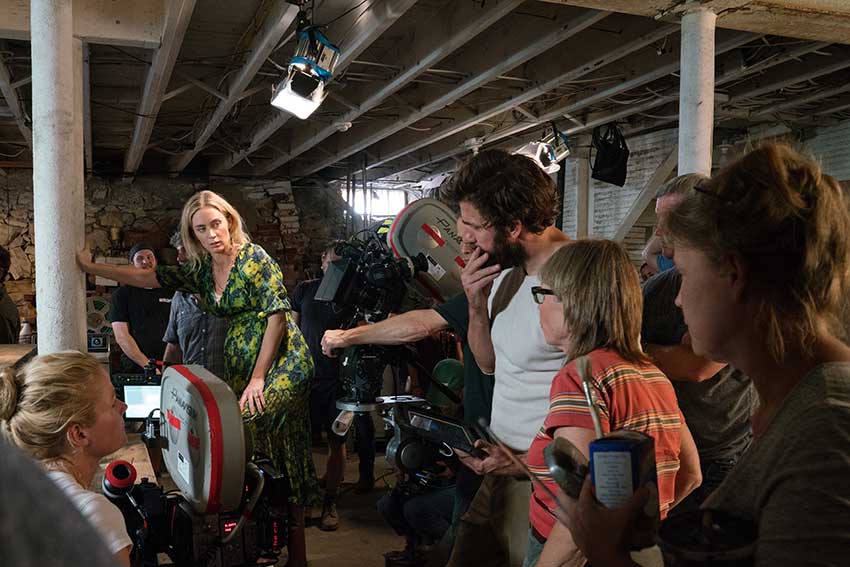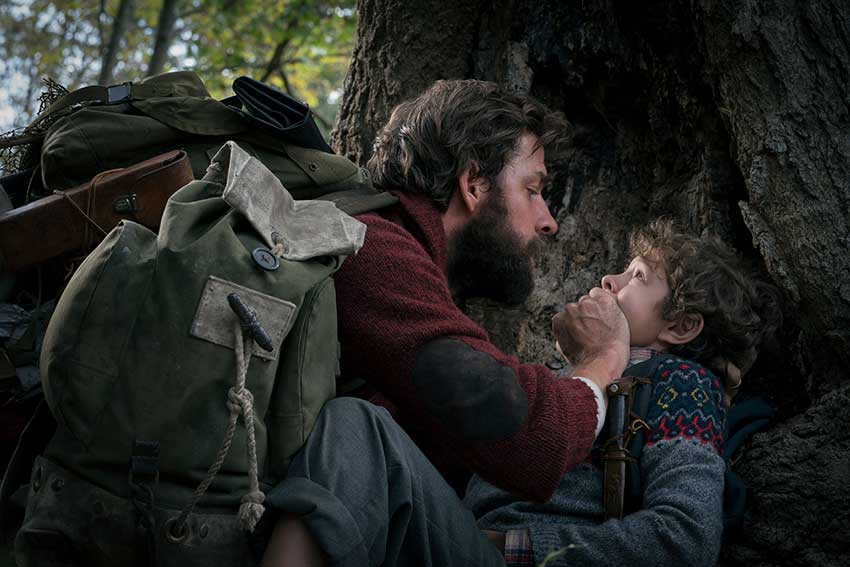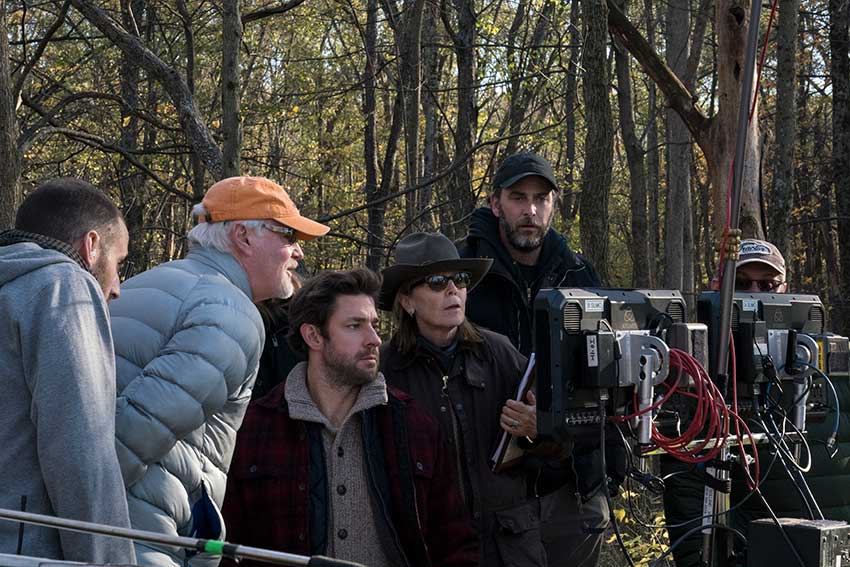How Did They Do That: Interview with 'A Quiet Place's' Special Effect Supervisor Mark Hawker
- Details
- Category: Interviews
- Created: Monday, 16 July 2018 22:56
- Published: Monday, 16 July 2018 23:46
- Written by Lupe R Haas

A QUIET PLACE director and star John Krasinksi went for old school scares along with old school special effects. It was special effects supervisor Mark Hawker’s job to deliver the practical effects for the hit horror thriller, and he tells CineMovie how they created the corn silo and the flooded basement scene.
In a A QUIET PLACE, a family must survive the apocalypse and alien monsters who attack on the faintest of sound. The film stars real-life husband and wife Emily Blunt and John Krasinski who also tackled directing and writing duties.
A QUIET PLACE earned $332 million worldwide, making it the most successful film of 2018 with a budget of $17 million which is pennies when it comes to Hollywood movies with special effects.
CineMovie spoke to special effects supervisor Mark Hawker who’s worked on the PIRATES OF THE CARIBBEAN movies, TRANSFORMERS: AGE OF EXTINCTION, A WRINKLE IN TIME, and the upcoming THE NEW MUTANTS and Ang Lee’s GEMINI MAN starring Will Smith.
A QUIET PLACE is now available on Digital, Blu-ray and DVD with loads of behind the scenes in the making of A QUIET PLACE. What you won’t see is how they constructed some of the most harrowing scenes in the movie with the corn silo and when a newborn is in a make-shift cradle while water slowly floods the basement. Mark Hawker breaks it down for us.
CineMovie: A QUIET PLACE was made on a shoestring budget for $17 million. What were some of your challenges since John wanted more practical effects rather than CGI?
Mark Hawker: The driving force was the budget, and I tried a lot of old school kind of stuff into it. Like working hand-in-hand with Scott Farrar and coming up with ways of... I don't want to say new ways because it's ways we used to do things, but with a little bit of his help it was definitely the best, most cost-effective way of achieving what we needed to achieve.

CineMovie: I've always wondered, is it less expensive to go the practical route, or to CGI it?
Mark: It depends. Like in some movies, other movies that I worked on, we will be all prepared to do it practically because it's always cheaper to do it practically, even if Visual Effects have to do a little clean up. But when it doesn't become cheaper is if the director might want to change his mind, like if there is a sequence of events happening in the scene. And once we do it practically then they are kind of stuck with like the sequence of it, but when it's visual effects the director has time to change and adjust things later. And sometimes if they're waiting for Practical Effects to do their thing and they're running out of time it just ends up being cheaper to do it visually than to keep the whole crew working on like a super long day kind of thing. So, there's a little bit of give-and-take both ways.
CineMovie: So, I was reading also that some of the effects started out as practical but ended up being digital. Can you tell me which parts?
Mark: Yes, with the creatures and stuff we would... we never planned on actually doing the creature practically of course. We had a stunt player that was dressed up in a gray suit that would be replaced by the creature. And a lot of the interaction with the environment and stuff where the creature is like down in the basement and when the sound, the hearing aid is getting to him and he's throwing stuff around, everything you're seeing move in that was done practically with us hooking it up to big pneumatic cylinders and pulling the stuff over. I'm trying to think of what got replaced. All the corn resolved practical, I am almost sure that Scott Farrar had to do maybe a little bit. But that was the thing that John Krasinski loved about the corn, it was there, real, on camera with the kids going down under. And I'm sure like with the nail, when she steps on the nail and pulls her foot up, I'm sure that some of that bizarre real nail, and that I'm sure Scott Farrar replaced some of it to make it look even more deadly than it actually looked or more painful.
CineMovie: I want to ask you about the corn silo. Do the young actors actually go under all that corn?
Mark: Yes. We did a bunch of tests with my effects brothers and tried different things. We tried doing it the old school way of doing it like how we would do sand, but the corn was really heavy and the thickness of the corn, so we had to make a rig that was like a floating rig underneath the corn that supported the weight of the corn but allowed the kids to walk around it. They'd go through about 6 to 12 inches of corn when they would sink in. And then underneath the corn is a basic room, there would be a couple stunt players there to help the kids through, and that place for them to breathe and stuff. And then if they wanted to go back up they just kind of stick their head through the rubber latex and push their way through.
CineMovie: Because they are children they are limited as far as time, so you guys have to work double time to get that scene, right?
Mark: Yes. The stunt players tested it, and then we were kind of nervous how the kids were going to be with it, but they actually had a really good time. The rig was pretty efficient, reset time and everything on it, so John was able to get a lot of stuff in a day's shoot with the kids.

CineMovie: And then I was watching the Behind the Scenes on the Blu-ray, they mentioned the fact that the crew had to be really, really quiet and still. That must have been pretty hard considering that you guys are at work all the time.
Mark: Yes, it's crazy because when I saw the Behind the Scenes too... when I read the script it was like, "Oh, yeah. Noises here and there aren't going to matter because there is no sound in the movie anyway." But no, it was super, duper, hyper sensitive to sound because any little sound just stood out. It was one of those movie sets where you were quiet, you didn't walk, you didn't move, you didn't even attempt to pick something up in case you drop something, or you drop your keys. It was pretty intense, but it was great, it makes for a good ceiling.
CineMovie: Yes, it's weird. Because you would think that they would remove that in post, but I guess you're dealing with a different kind of film where as a viewer we can hear people munching on their popcorn and candy.
Mark: Yes. And all those people at the theater then start staring at them like, "Why are they so noisy?"
CineMovie: That was quite a unique experience, I was actually laughing. And can you talk about John Krasinski as a director? I think everybody was surprised he gave us this great movie because we don't see him as a director, we see him as an actor.
Mark: He's great as a director, he had his vision and he communicated it very well to the crew. He made the crew feel part of his vision instead of it just being all his. It was great, it was really good and had a great sense of the drama off the show, and very passionate for it. It was his baby for sure.

CineMovie: Since he wanted to do everything in camera, what was the most challenging?
Mark: Well, I think that the corn silo was one of the challenging, and then one of the other challenging sets was the safe room that gets flooded. Normally we would build a tank, and then construction is built inside of the tank and it takes up a lot of space and it's a lot more water to filter and the crew is working in the water. But we came up with this way of actually making the walls of the set hold the water back, those structural walls that can hold back like 16,000 gallons of water, and it still allowed the crew to get right up to the set and you just pull the wall above out. It was like a double section. There was like four feet of wall that wasn't removable that held the water back, and then above that you could pull it off, so if they needed to put camera angles at different angles they have a wall that's wild and can pull it out. And then the art department built our walls into the set so it was seamless. And then it just took up a lot less real estate, and heating and filtering and all that stuff was a lot less because you're not dealing with as much water as you normally would.
CineMovie: Did you have to actually deal with a real baby? Did they put a real baby in those situations?
Mark: There was a real baby for the real close-ups, and I think anything else other than that is a doll. And then I'm sure that probably visual effects helped take that doll and bring it to life a little bit, mainly the tight shots. They had the baby obviously very well taken care of and watched over and everything like that.
CineMovie: That was a pretty frightening scene.
Mark: Yes. Putting the baby inside a box and closing it up in all that water, yes.
CineMovie: And then you just recently wrapped Gemini Man and you're working on other projects. How is cool that?
Mark: That was cool. I've worked with Ang Lee in the past and I like him a lot. I like his visions. And he wants to have a different medium that people watch, and that was what Gemini Man was. It was 120 frames, shot in 120 frames and played back in 120 frames, so the detail is completely like you're looking at it with your eyeball, it's crazy.
CineMovie: How does that affect your job?
Mark: That made it tougher. We had to come up with another way, a new way of doing things because you see every little detail and there's no motion blur, and we rely on motion blur to help to hide a lot of our flaws when we're doing a gag. Even basic bullet heads had to be tested and retested and come up with a different light so that didn't look like they do, to make them look more realistic, because it just picks up everything, that format.
CineMovie: Well, thank you so much. I really enjoyed A QUIET PLACE, and I'm going to watch it again and enjoy your effects.
Mark: Great. Thank you very much.